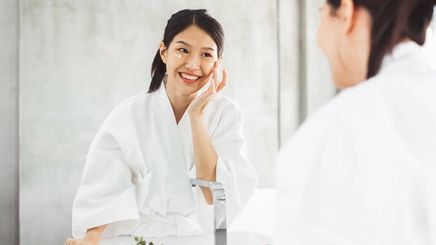
Yet another uniquely female form of torture is hormonal acne. It is a form of acne influenced by hormonal fluctuations, usually due to menstruation and menopause. It can appear as different types of acne, from painful cysts to clusters of blackheads, and on . Read on to know more about hormonal acne and how to deal with these painful breakouts.
Characteristics of Hormonal Acne
is a breakout that occurs during your period or, to some, when experiencing menopause. It can occur at any age. During puberty, hormonal acne can appear in the T-zone. On the other hand, adult hormonal acne appears on the lower part of the face, such as the cheeks and jawline.
While it's difficult to pinpoint the actual cause of a breakout, hormonal imbalances can factor in any noticeable increase in acne. According to the American Academy of Dermatology, hormonal fluctuations can aggravate acne-prone skin by triggering inflammation, increasing sebum production, therefore, clogging the pores, and increasing the production of acne-causing bacteria.
Traditional Treatments
If you’re experiencing hormonal breakouts, it’s best to consult with your dermatologist on the best course of treatment. They may recommend oral contraceptives, anti-androgen drugs, or , which are among the more traditional treatments that stabilize hormone levels and calm inflammation. On the other hand, topical remedies such as tea tree oil, green tea, and AHAs have also been known to decrease inflammation as well as aid in exfoliation.
Watch Your Diet
A study in the National Institutes of Health notes that some inflammation-fighting foods may help with preventing hormonal acne. These include vegetables that are high in antioxidants and foods that are rich in Omega-3 fatty acids. It is also ideal to limit your intake of processed foods, sugars, dairy products, refined carbohydrates, and red meat. You know your skin best, so observe how it behaves whenever you overindulge and try to avoid your triggers.
Adjust Your Skincare Routine
Hormonal acne makes your face feel quite raw and painful. It can also feel very oily from the overproduction of sebum, yet very dry from medications and topical treatments. If you have , you must adjust your skincare routine to suit your skin condition.
Switch to a gentle, oil-free facial cleanser and wash your face every morning and evening. Make sure to moisturize your skin as well, since topical treatments can be irritating and drying. Use POND'S Aloe Vera Jelly Cleanser and Moisturizer, which soothes and moisturizes your skin with a light, gel formula.
Curb oil with a micellar cleanser such as Eskinol Naturals Micellar Water Clear with Natural Lemon Extracts, which mattifies without stripping the skin of its natural oils. And don’t forget to slather on a generous amount of SPF before stepping out.
If your hormonal acne persists, consult your doctor. In the meantime, stick to your skincare routine, eat well, and don’t touch your face!